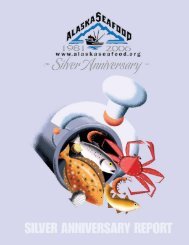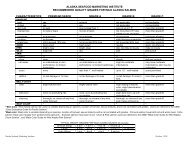Purchasing/ReceivingAs a rule, high-grade <strong>salmon</strong> <strong>caviar</strong> has a consistentbright, red-orange outer color with a center thecolor and consistency of honey. Eggs should beshiny and slightly transparent, whole (not broken orsquashed) and easily separated from one another.In general, <strong>caviar</strong> is graded on the basis of egg size(larger is better), salt content (lower is better) anddrip (zero is best). High-grade <strong>caviar</strong> eggs shouldbe firm but pliable to pressure without breakage.<strong>Alaska</strong> <strong>salmon</strong> <strong>caviar</strong> should have a mild, pleasantsmell and a rich taste.To provide additional product safety andincrease shelf life, some <strong>salmon</strong> <strong>caviar</strong> is soldpasteurized. Product taste is not significantlyaffected by pasteurization. Pasteurized productmay be softer, lighter in color, and less shiny inappearance than non-pasteurized product. Morejuice is also accepted in non-pasteurized product.In general, higher-grade <strong>caviar</strong> can withstand thepasteurization process best.Some <strong>Alaska</strong> producers pack <strong>caviar</strong> in modifiedatmosphere packaging (MAP) trays. These aresealed trays that are either flushed with nitrogengas to remove the oxygen, or contain packets ofoxygen-consuming granules. By minimizing theoxidation of oils in the eggs, the frozen shelf lifecan be increased.KETA SALMON, Oncorhynchus keta<strong>Alaska</strong> keta <strong>salmon</strong> are harvested in late summer. Keta<strong>salmon</strong> roe is pale red with strong orange overtones.Keta <strong>caviar</strong> is the most popular type of <strong>salmon</strong> <strong>caviar</strong>,prized for its large size. The highest-grade keta <strong>caviar</strong> is5 mm or larger with a salt content of 2.5 to 3.5 percentand zero drip.* Keta <strong>caviar</strong> is also regarded for its flavor,long shelf life and signature “pop” in the mouth.PINK SALMON, Oncorhynchus gorbuscha<strong>Alaska</strong> pink <strong>salmon</strong>, the smallest and most abundantof the <strong>Alaska</strong> <strong>salmon</strong> species, are harvested in latesummer. Pink <strong>salmon</strong> roe is orange with a subtle rosehue. The highest-grade pink <strong>caviar</strong> is 3.5 mm or largerin size, with a salt content of 2.5 to 3.5 percent andzero drip.* Pink <strong>caviar</strong> is valued for its sweet, mildtaste and long shelf life.*Salmon roe of smaller size or higher salt content is graded according to individual company specifications. Producers have their own specifications,so it is important for buyers to work closely with their suppliers.Note: Caviar salt content is market determined and is not subject to food safety regulations.
StorageSalmon <strong>caviar</strong> can be frozen to increase shelf life.As with pasteurization, higher quality product isbetter suited for freezing. While other types of<strong>caviar</strong>, such as sturgeon, are not suited for freezing,<strong>salmon</strong> eggs have thick membranes that preventdamage. The salt content in <strong>salmon</strong> <strong>caviar</strong> causesfreezing to take place at low temperatures.For long-term storage, -40° C is recommended.Thawing should take place slowly in order topreserve quality. Caviar in wholesale packages isnormally kept frozen below -10° C.Steve LeeSOCKEYE SALMON, Oncorhynchus nerkaMost <strong>Alaska</strong> sockeye <strong>salmon</strong> are caught in mid-summer.Sockeye <strong>salmon</strong> roe is bright red and significantlysmaller than that of the other <strong>salmon</strong> species. Muchof the sockeye roe harvest is sold in-sac (as sujiko),though some is used for <strong>caviar</strong>. The highest-gradesockeye <strong>caviar</strong> is 2.5 mm and up and has a saltcontent of 2.5 to 3.5 percent and no drip.* Sockeye<strong>caviar</strong> can have a slightly bitter natural finish andhas a shorter shelf life than other species due to thenatural fats found in the yolk of the eggs.COHO SALMON, Oncorhynchus kisutch<strong>Alaska</strong> coho <strong>salmon</strong> run later than the other speciesand are generally the last to spawn. Coho <strong>salmon</strong> roeis mid-sized and closer to red than orange in color.The highest-grade coho <strong>caviar</strong> is 4.5 mm and up, witha salt content of 2.5 to 3.5 percent and no drip.* Likesockeye, coho <strong>caviar</strong> has a slightly bitter natural finishand shorter shelf life caused by unstable fatty acids.








